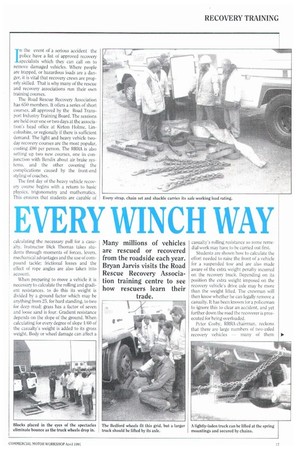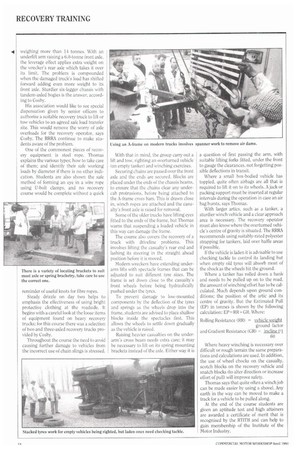EVERY WINCH WAY
Page 101

Page 102

If you've noticed an error in this article please click here to report it so we can fix it.
In the event of a serious accident the police have a list of approved recovery specialists which they can Call on to remove damaged vehicles. Where people are trapped, or hazardous loads are a danger, it is vital that recovery crews are properly skilled. That is why many of the rescue and recovery associations run their own training courses.
The Road Rescue Recovery Association has 650 members. It offers a series of short courses, all approved by the Road Transport Industry Training Board. The sessions are held over one or two days at the association's head office at Kirton Mime, Lincolnshire, or regionally if there is sufficient demand. The light and heavy vehicle twoday recovery courses are the most popular, costing £90 per person. The RRRA is also setting up two new courses, one in conjunction with Bendix about air brake systems. and the other covering the complications caused by the front-end styling of coaches.
The first day of the heavy vehicle recovery course begins with a return to basic physics, trigonometry and mathematics. This ensures that students are capable of calculating the necessary pull for a casualty. Instructor Dick Thomas takes students through moments of forces, levers. mechanical advantages and the use of compound tackle; frictional losses and the effect of rope angles are also taken into account.
When preparing to move a vehicle it is necessary to calculate the rolling and gradient resistances. to do this its weight is divided by a ground factor which may be anything from 25, for hard standing. to two for deep mud; grass has a factor of seven and loose sand is four. Gradient resistance depends on the slope of the ground. When calculating for every degree of slope 1/60 of the casualty's weight is added to its gross weight. Body or wheel damage can affect a casualty's rolling resistance so some remedial work may have to be carried out first.
Students are shown how to calculate the effort needed lo raise the front of a vehicle for a suspended Low and are also made aware of the extra weight penalty incurred on the recovery truck. Depending on its position the extra weight imposed on the recovery vehicle's drive axle may be more than the weight lifted. The crewman will then know whether he can legally remove a casualty. It has been known Jar a policeman to ignore this to clear an accident, and yet further down the road the recoverer is prosecuted for being overloaded.
Peter Cosby, RRRA chairman, reckons that there are large numbers of two-axled recovery vehicles -many of them weighing more than 14 tonnes. With an underlift arm raising a 6.0-tonne front axle. the leverage effect applies extra weight on the wrecker's rear axle which takes it over its limit. The problem is compounded when the damaged truck's load has shifted forward adding even more weight to its front axle. Sturdier six-legger chassis with tandem-axled bogies is the answer, according to Cosby.
His association would like to see special dispensation given by senior officers to authorise a suitable recovery truck to lift or tow vehicles to an agreed safe load transfer site. This would remove the worry of axle overloads for the recovery operator, says Cosby. The RRRA continue to make students aware of the problem.
One of the commonest pieces of recovery equipment is steel rope. Thomas explains the various types; how to take care of them; and identify their safe working loads by diameter if there is no other indication. Students are also shown the safe method of forming an eye in a wire rope using U-bolt clamps, and no recovery course would be complete without a quick reminder of useful knots for fibre ropes.
Steady drizzle on day two helps to emphasis the effectiveness of using bright protective clothing at the roadside. It begins with a careful look at the loose items of equipment found on heavy recovery trucks; for this course there was a selection of two and three-axled recovery trucks provided by Cosby, Throughout the course the need to avoid causing further damage to vehicles from the incorrect use of chain slings is stressed. With that in mind, the group carry out a lift and tow, righting an overturned vehicle (an empty tanker} and winching exercises.
Securing chains are passed over the front axle and the ends are secured. Blocks are placed under the ends of the chassis beams, to ensure that the chains clear any undercab protrusions, before being attached to the A-frame cross bars. This is drawn close in, winch ropes are attached and the casualty's front axle is raised for removal.
Some of the older trucks have lifting eyes fitted to the ends of the frame, but Thomas warns that suspending a loaded vehicle in this way can damage the frame.
The course also covers the recovery of a truck with driveline problems. This involves lifting the casualty's rear end and lashing its steering in the straight ahead position before it is moved.
Modern wreckers have extending underarm lifts with spectacle frames that can be adjusted to suit different tyre sizes. The frame is set down close to the casualty's front wheels before being hydraulically pushed under the tyres.
To prevent damage to low-mounted components by the deflection of the tyres and springs as the wheels drop into the frame, students are advised to place shallow blocks inside the spectacles first. This allows the wheels to settle down gradually as the vehicle is raised.
Raising heavier casualties on the underarm's cross beam needs extra care; it may be necessary to lift on its spring mounting brackets instead of the axle. Either way it is
a question of first passing the arm, with suitable lifting forks fitted, under the front to gauge the clearances, not forgetting possible deflections in transit.
Where a small box-bodied vehicle has toppled, quite often airbags are all that is required to lift it on to its wheels. A jack or packing support must be inserted at regular intervals during the operation in case an air bag bursts, says Thomas.
With larger artics. such as a tanker, a sturdier winch vehicle and a clear approach area is necessary. The recovery operator must also know where the overturned vehicle's centre of gravity is situated. The RRRA recommends using suitably-rated polyester strapping for tankers, laid over baffle areas if possible_ If the vehicle is laden it is advisable to use checking tackle to control its landing but when empty old tyres will absorb most of the shock as the wheels hit the ground.
Where a tanker has rolled down a bank and needs to be pulled up on to the road, the amount of winching effort has to be calculated. Much depends upon ground conditions; the position of the artic and its centre of gravity. But the Estimated Pull (EP) in tonne S is shown by the following calculation: EP= RR+GR. Where:
Rolling Resistance (RR) = vehicle weight ground factor and Gradient Resistance (GR) = incline l'11 60
Where heavy winching is necessary over difficult or rough terrain the same preparations and calculations are used. In addition, the use of wheel chocks on the casualty, scotch blocks on the recovery vehicle and snatch blocks (to alter direction or increase effort of pull) will improve safety.
Thomas says that quite often a winch job can be made easier by using a shovel. Any earth in the way can be moved to make a track for a vehicle to be pulled along.
At the end of the course students are given an aptitude test and high attainers are awarded a certificate of merit that is recognised by the RTITB and can help to gain membership of the Institute of the Motor Industry.












































































































